16 May Learn the basics of the forge with Blacksmithing Instructor April Franklin
[vc_row css_animation="" row_type="row" use_row_as_full_screen_section="no" type="full_width"...

[vc_row css_animation="" row_type="row" use_row_as_full_screen_section="no" type="full_width"...
[vc_row css_animation="" row_type="row" use_row_as_full_screen_section="no" type="full_width"...
[vc_row css_animation="" row_type="row" use_row_as_full_screen_section="no" type="full_width"...
[vc_row css_animation="" row_type="row" use_row_as_full_screen_section="no" type="full_width"...
In December of 2020, Lynda...
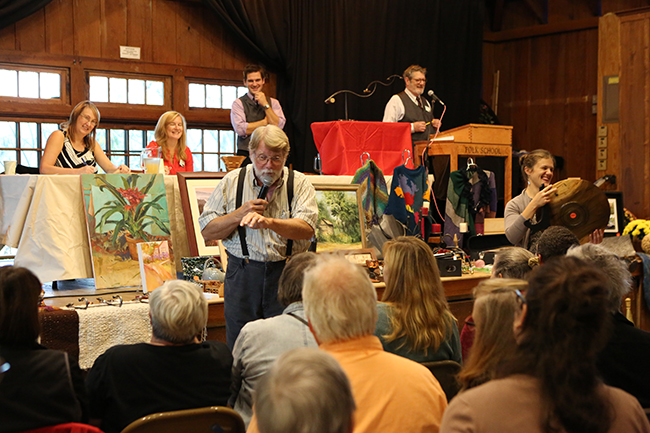 I first met Tim Ryan on a misty morning in the Folk School Garden when I was a Work/Study in 2011. My immediate impression of him was that he was a very witty & interesting character with lots of fantastic stories. Tim is involved in the Folk School in so many different ways. I thought this would be a good moment to sit down and learn a little bit about Tim the gardener, auctioneer, medicine showman, raconteur, kettle cooker, blacksmith, instructor, former Folk School Board member, bibliophile, and storyteller, that is Tim Ryan. We recently sat down over lunch to talk about many things. Enjoy our interview!
CP: When did you first come to the Folk School?
[caption id="attachment_15023" align="alignright" width="289"]
I first met Tim Ryan on a misty morning in the Folk School Garden when I was a Work/Study in 2011. My immediate impression of him was that he was a very witty & interesting character with lots of fantastic stories. Tim is involved in the Folk School in so many different ways. I thought this would be a good moment to sit down and learn a little bit about Tim the gardener, auctioneer, medicine showman, raconteur, kettle cooker, blacksmith, instructor, former Folk School Board member, bibliophile, and storyteller, that is Tim Ryan. We recently sat down over lunch to talk about many things. Enjoy our interview!
CP: When did you first come to the Folk School?
[caption id="attachment_15023" align="alignright" width="289"]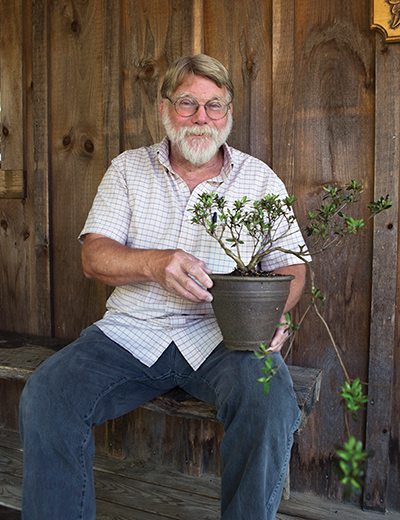 Tim Ryan with a bonsai tree[/caption]
TR: I had gotten divorced and it killed me. This was 26 years ago. I was depressed and blue and three things saved me: my Blacksmithing buddies, Al-Anon, and having a daughter.
At one of the Appalachian Area Chapter Blacksmith Meetings in Mt. Juliet TN, they were having a raffle and the winner would get a free class at the Folk School. Well I don’t usually enter raffles, but my Blacksmithing buddies convinced me to enter and I won. I think they set it up because I was depressed and they knew I needed something else to focus on. It worked because I won the raffle in March or April and the class wasn’t until October, so all summer long I worked hard to become a better blacksmith, worthy of the class at the Folk School.
In the fall of 1990, I used my scholarship to take a 2-week Blacksmithing class at the Folk School with Francis Whitaker, which I was by no means near prepared for, naturally.
[caption id="attachment_15036" align="aligncenter" width="630"]
Tim Ryan with a bonsai tree[/caption]
TR: I had gotten divorced and it killed me. This was 26 years ago. I was depressed and blue and three things saved me: my Blacksmithing buddies, Al-Anon, and having a daughter.
At one of the Appalachian Area Chapter Blacksmith Meetings in Mt. Juliet TN, they were having a raffle and the winner would get a free class at the Folk School. Well I don’t usually enter raffles, but my Blacksmithing buddies convinced me to enter and I won. I think they set it up because I was depressed and they knew I needed something else to focus on. It worked because I won the raffle in March or April and the class wasn’t until October, so all summer long I worked hard to become a better blacksmith, worthy of the class at the Folk School.
In the fall of 1990, I used my scholarship to take a 2-week Blacksmithing class at the Folk School with Francis Whitaker, which I was by no means near prepared for, naturally.
[caption id="attachment_15036" align="aligncenter" width="630"]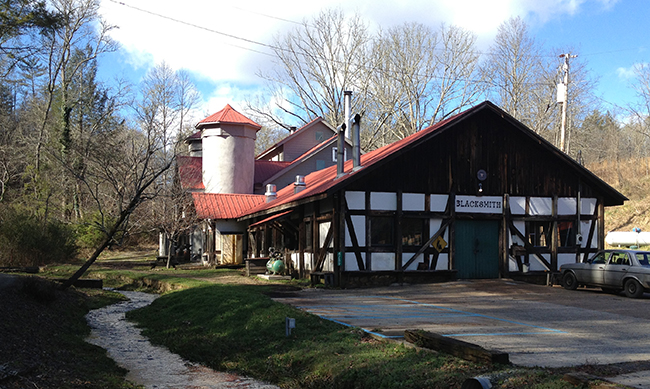 The Folk School Blacksmith Shop (Original Francis Whitaker Shop in the foreground, the new Clay Spencer Shop in the background)[/caption]
The Folk School Blacksmith Shop (Original Francis Whitaker Shop in the foreground, the new Clay Spencer Shop in the background)[/caption]
This week for our celebration...
A big congratulations to Brasstown...
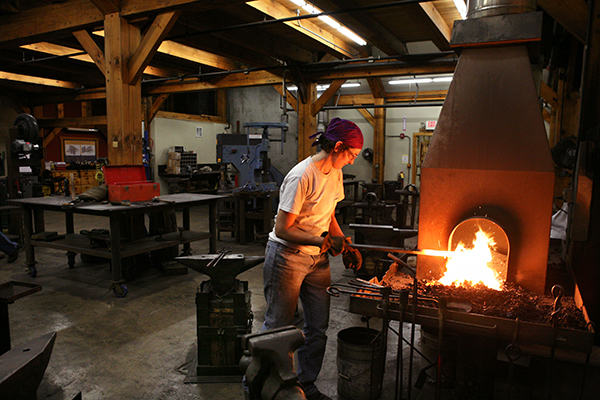 See blacksmiths in action forging items in the Clay Spencer Blacksmith Shop on October 31 at 7 p.m. Items created will be auctioned off the following day at the Blacksmith & Fine Craft Auction.[/caption]
CP: So, the Blacksmith & Fine Craft Auction is coming up on November 1. I hear there’s going to be a new special event on Friday night. Can you talk about that?
PG: I can. Traditionally, there has been a joint meeting of the Appalachian Area Chapter of Blacksmiths (AACB) and NC ABANA at the Folk School during the auction weekend. The meeting is on Saturday morning, bright and early.
[caption id="attachment_11683" align="alignright" width="320"]
See blacksmiths in action forging items in the Clay Spencer Blacksmith Shop on October 31 at 7 p.m. Items created will be auctioned off the following day at the Blacksmith & Fine Craft Auction.[/caption]
CP: So, the Blacksmith & Fine Craft Auction is coming up on November 1. I hear there’s going to be a new special event on Friday night. Can you talk about that?
PG: I can. Traditionally, there has been a joint meeting of the Appalachian Area Chapter of Blacksmiths (AACB) and NC ABANA at the Folk School during the auction weekend. The meeting is on Saturday morning, bright and early.
[caption id="attachment_11683" align="alignright" width="320"]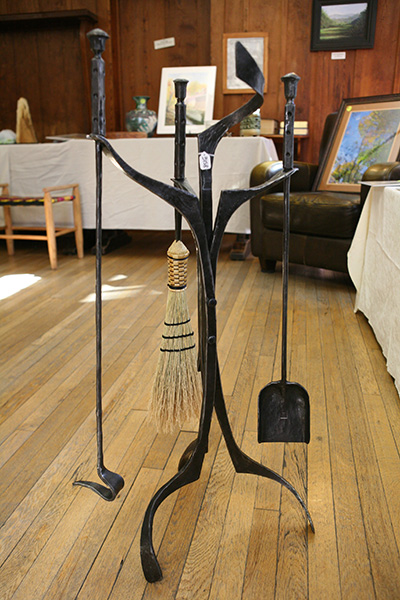 Fire place set forged at the "Hammer In" 2013[/caption]
I had been trying to think of a way to expand the meeting and make it more appealing for smiths to stay over on Friday night. Last year, we tried a small invitational Friday night “Hammer In” (A "Hammer In" is where blacksmiths get together and make things collaboratively). It went really well. We made a few things for the auction, including a fireplace set, and it was encouraging enough to try it again this year.
I put the word out to members of the blacksmith chapters and we are expecting quite a few smiths on the evening of October 31st. We are opening the shop up to auction goers to come and see what’s involved in the work and to observe how the items are handcrafted. I believe it will add value and interest to the pieces if folks can see the forging process.
Tim Ryan is going to have a kettle of cooked goodness to offer up for a small cost per bowl. It’s gonna be fun! We are going to have a few set projects: a fire tools set and maybe a sculptural piece. Blacksmiths can forge smaller items too. It’ll be a good crowd.
Fire place set forged at the "Hammer In" 2013[/caption]
I had been trying to think of a way to expand the meeting and make it more appealing for smiths to stay over on Friday night. Last year, we tried a small invitational Friday night “Hammer In” (A "Hammer In" is where blacksmiths get together and make things collaboratively). It went really well. We made a few things for the auction, including a fireplace set, and it was encouraging enough to try it again this year.
I put the word out to members of the blacksmith chapters and we are expecting quite a few smiths on the evening of October 31st. We are opening the shop up to auction goers to come and see what’s involved in the work and to observe how the items are handcrafted. I believe it will add value and interest to the pieces if folks can see the forging process.
Tim Ryan is going to have a kettle of cooked goodness to offer up for a small cost per bowl. It’s gonna be fun! We are going to have a few set projects: a fire tools set and maybe a sculptural piece. Blacksmiths can forge smaller items too. It’ll be a good crowd.
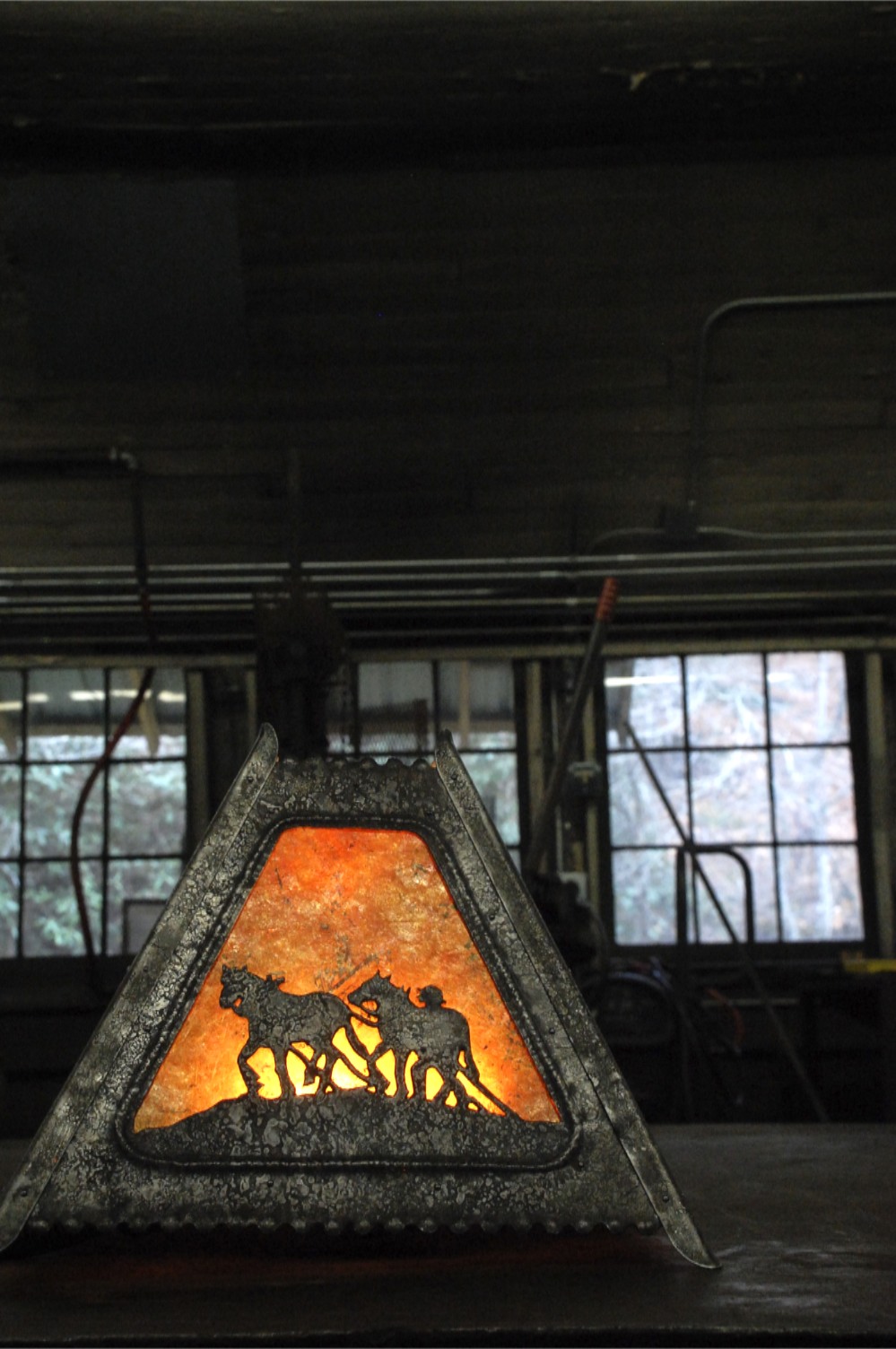 Sing Behind the Plow lampshade by Ron Nichols[/caption]
Blacksmith Work Week is an annual Folk School tradition, bringing 20 professional blacksmiths/instructors from around the country together to volunteer their time for the purposes of 1) beautifying the Folk School campus with functional ironwork; 2) repairing and creating new tools and infrastructure for the Blacksmithing program; and 3) spending a week learning and exchanging in the company of peers and mentors.Work Week was started by Clay Spencer (namesake of the new blacksmith shop) in the early 1990s and is currently coordinated by Paul Garrett, resident artist blacksmith. I had the chance to visit the shop and interview some of the blacksmiths as they put finishing touches on their projects and reflected on their connection to this very special community and yearly opportunity to participate in Work Week.
Leah Dolgoy: Paul, how’s it gone this week? What were your priority projects and what’s been accomplished during Work Week?
Paul Garrett: There were many priorities this year. One was making chandeliers for upstairs. They won’t get done this year but we’ll keep working on them next year. The shop is named after Clay Spencer so I gave Clay free reign on the design and he chose something very contemporary and out of the ordinary. Other priorities included work in some of the studios. We mounted some equipment for the Jewelry studio. We built a pot rack for the cooking studio. And we finished installing the door latches I made for the main door to the new blacksmith shop. We made two treadle hammers, and two treadle torches. We fixed a lot of tools – hammers and tongs, punches and grips. We also do whatever else pops up. I really wanted to do the Keith House door so that got done this year. We etched and epoxied the bathroom floor in the shop so that housekeeping can come in and clean it more easily now. Then there are all the little things that come up. I have these little job sheets that I put out and I find that works well. People pick their jobs based on their area of interest and expertise.
LD: What does it mean to be the coordinator of this thing that everyone regards as so special?
[caption id="attachment_10391" align="alignright" width="232"]
Sing Behind the Plow lampshade by Ron Nichols[/caption]
Blacksmith Work Week is an annual Folk School tradition, bringing 20 professional blacksmiths/instructors from around the country together to volunteer their time for the purposes of 1) beautifying the Folk School campus with functional ironwork; 2) repairing and creating new tools and infrastructure for the Blacksmithing program; and 3) spending a week learning and exchanging in the company of peers and mentors.Work Week was started by Clay Spencer (namesake of the new blacksmith shop) in the early 1990s and is currently coordinated by Paul Garrett, resident artist blacksmith. I had the chance to visit the shop and interview some of the blacksmiths as they put finishing touches on their projects and reflected on their connection to this very special community and yearly opportunity to participate in Work Week.
Leah Dolgoy: Paul, how’s it gone this week? What were your priority projects and what’s been accomplished during Work Week?
Paul Garrett: There were many priorities this year. One was making chandeliers for upstairs. They won’t get done this year but we’ll keep working on them next year. The shop is named after Clay Spencer so I gave Clay free reign on the design and he chose something very contemporary and out of the ordinary. Other priorities included work in some of the studios. We mounted some equipment for the Jewelry studio. We built a pot rack for the cooking studio. And we finished installing the door latches I made for the main door to the new blacksmith shop. We made two treadle hammers, and two treadle torches. We fixed a lot of tools – hammers and tongs, punches and grips. We also do whatever else pops up. I really wanted to do the Keith House door so that got done this year. We etched and epoxied the bathroom floor in the shop so that housekeeping can come in and clean it more easily now. Then there are all the little things that come up. I have these little job sheets that I put out and I find that works well. People pick their jobs based on their area of interest and expertise.
LD: What does it mean to be the coordinator of this thing that everyone regards as so special?
[caption id="attachment_10391" align="alignright" width="232"]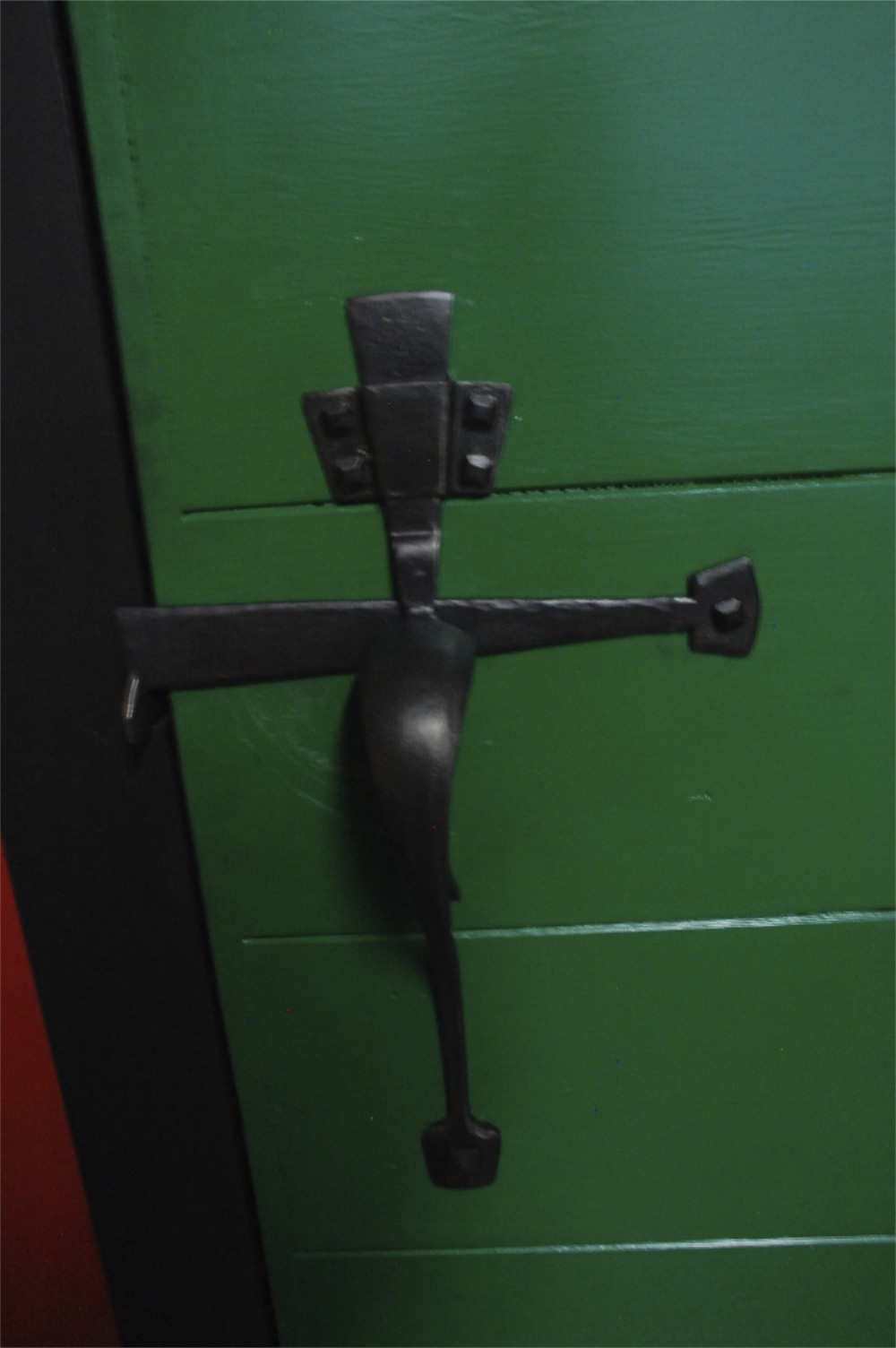 New door hardware for the Blacksmith Shop made by Paul Garrett[/caption]
PG: For me, it’s an honor and a privilege to be a part of Work Week. I just love having everyone here. As the coordinator, it’s up to me to make the most of it. We have 1000 hours of volunteer labor every year. My role is to keep everyone else working, and to make sure that they can get what they need to get the job done. Funny story - 13 or 14 years ago I came here as a student, and I asked Clay if I could come to Work Week. And basically he said no, because he had enough people and he didn’t really know me that well. (laughs) It wasn’t to be mean or anything. He just had his team that he needed. I understand that now that I am on the other side of it. I believe this is my 10th year as the Work Week coordinator.
New door hardware for the Blacksmith Shop made by Paul Garrett[/caption]
PG: For me, it’s an honor and a privilege to be a part of Work Week. I just love having everyone here. As the coordinator, it’s up to me to make the most of it. We have 1000 hours of volunteer labor every year. My role is to keep everyone else working, and to make sure that they can get what they need to get the job done. Funny story - 13 or 14 years ago I came here as a student, and I asked Clay if I could come to Work Week. And basically he said no, because he had enough people and he didn’t really know me that well. (laughs) It wasn’t to be mean or anything. He just had his team that he needed. I understand that now that I am on the other side of it. I believe this is my 10th year as the Work Week coordinator.


